A coded MIMO-OFDM system’s performance comparison of the spatial channel model and the onering channel model based on interpolation techniques
In this paper, we consider to estimate the channel coefficient in the wideband and frequency selective multiinput multi-Output orthogonal frequency division multiplexing (MIMO-OFDM) system. The simulation is based on two channel models, one has been proposed by the 3rd Generation Partnership Project (3GPP) standard - the Spatial Channel Model (SCM) and the other is the Onering channel model, under the LTE Advanced standard for 4G in the suburban macro-cell environment. The obtained results show the symbol error rate (SER) value when using different interpolations (Linear, Sinc or Wiener) with the same input parameters. The Space Frequency Block Coding (SFBC) and minimum mean-squared error (MMSE) equalizer are also used for the simulation of the MIMO 2x2 systems. The SER results in the SCM channel model are lower than that obtained by the Onering channel model when employing the different interpolation methods
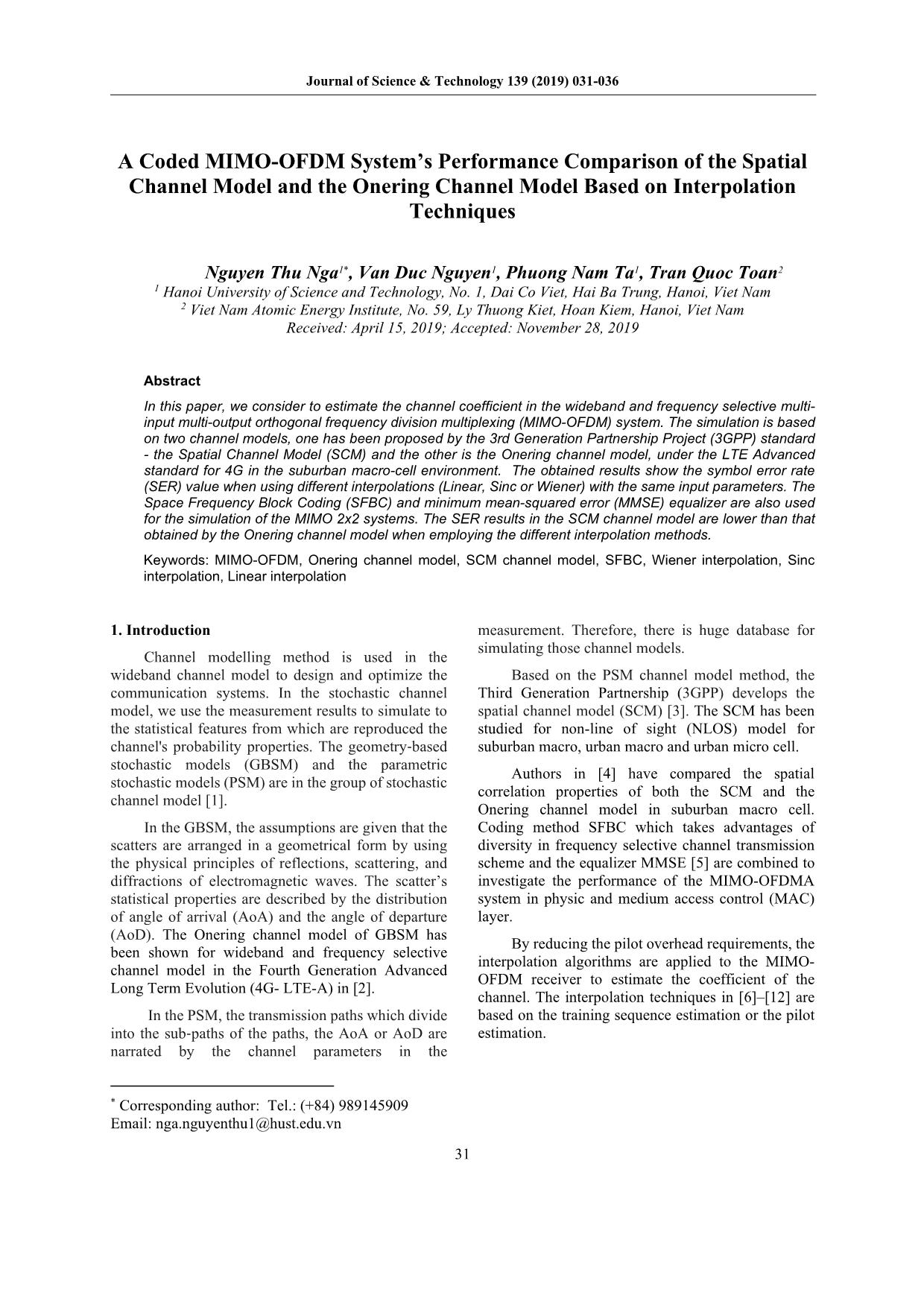
Trang 1
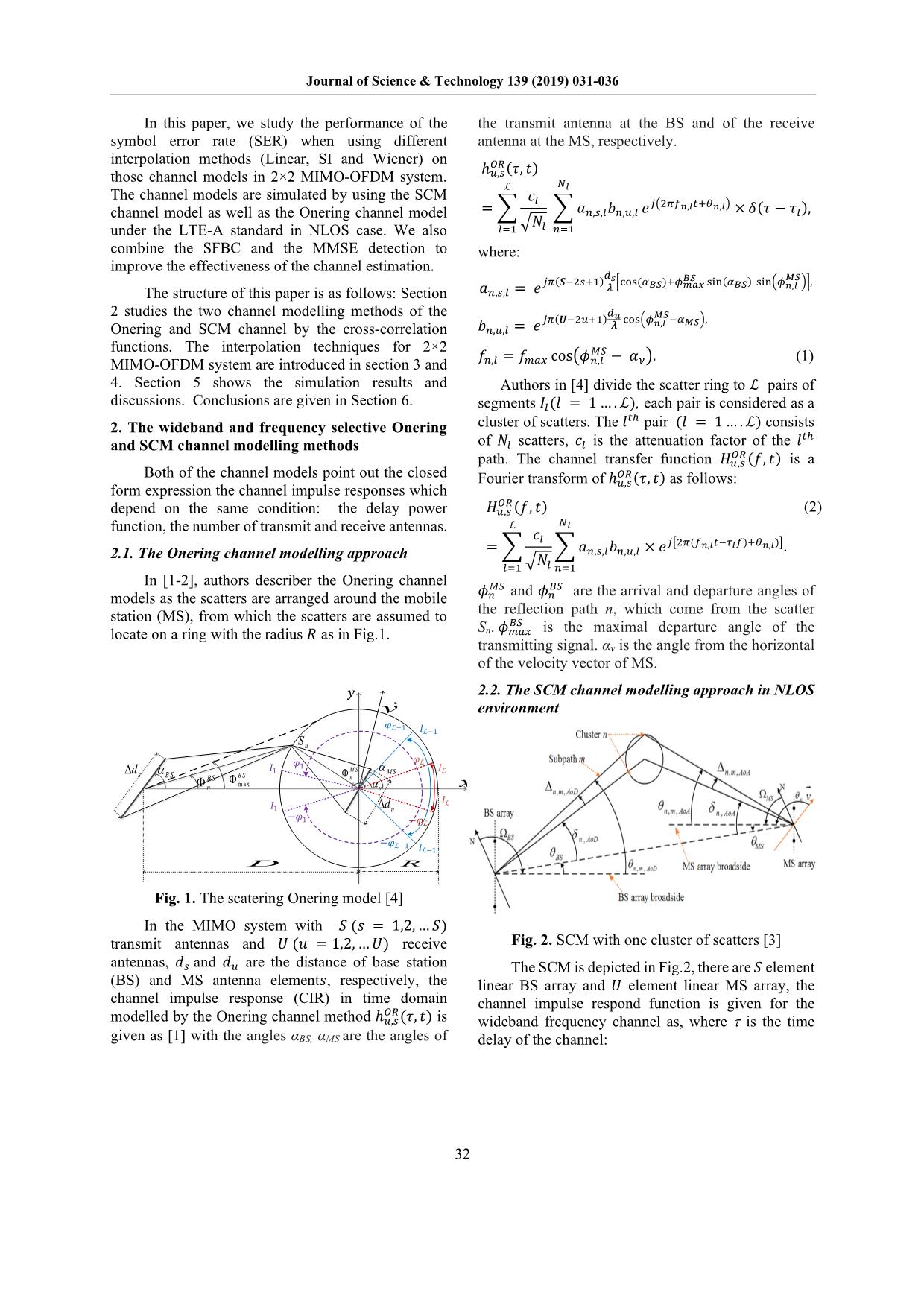
Trang 2
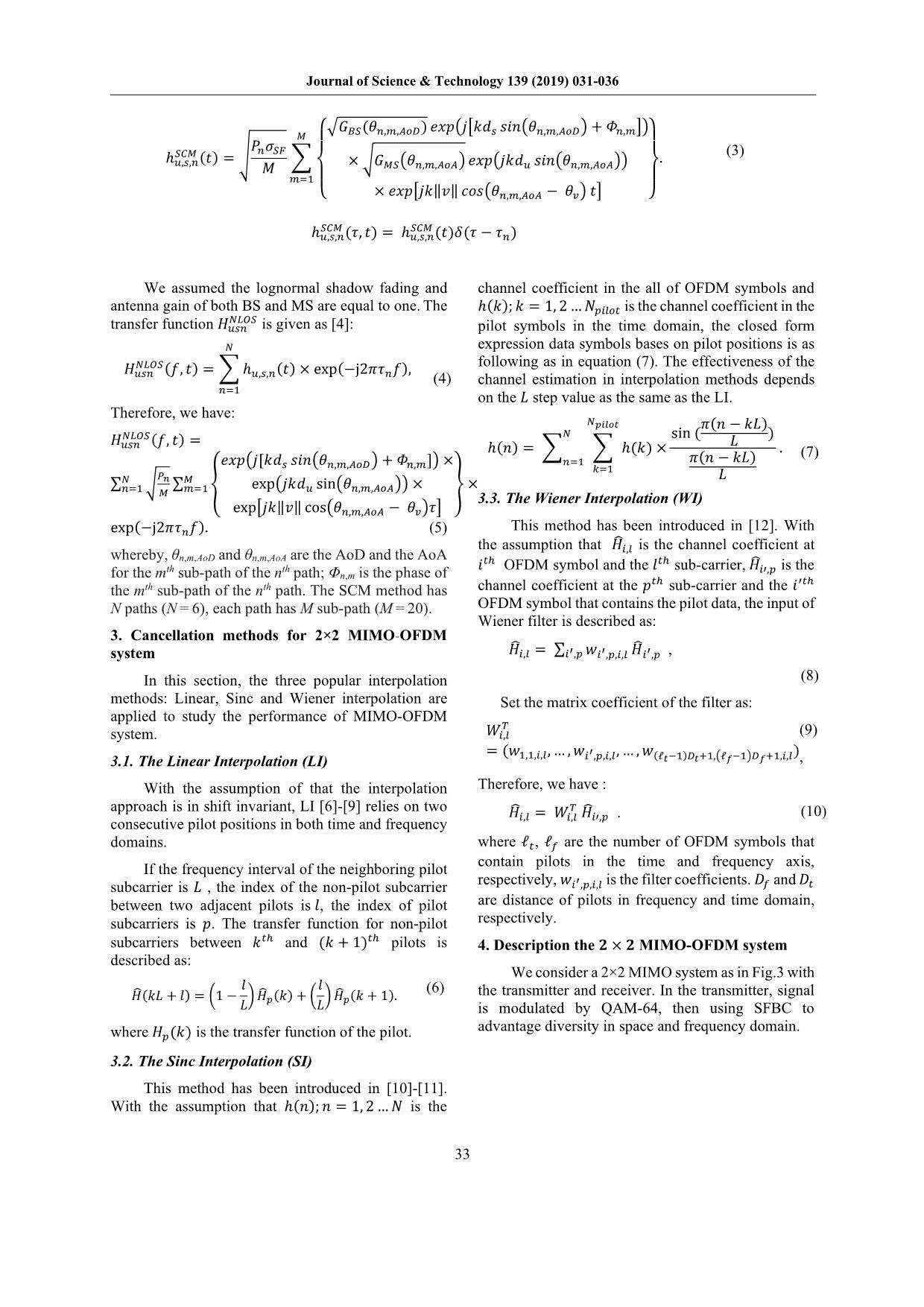
Trang 3
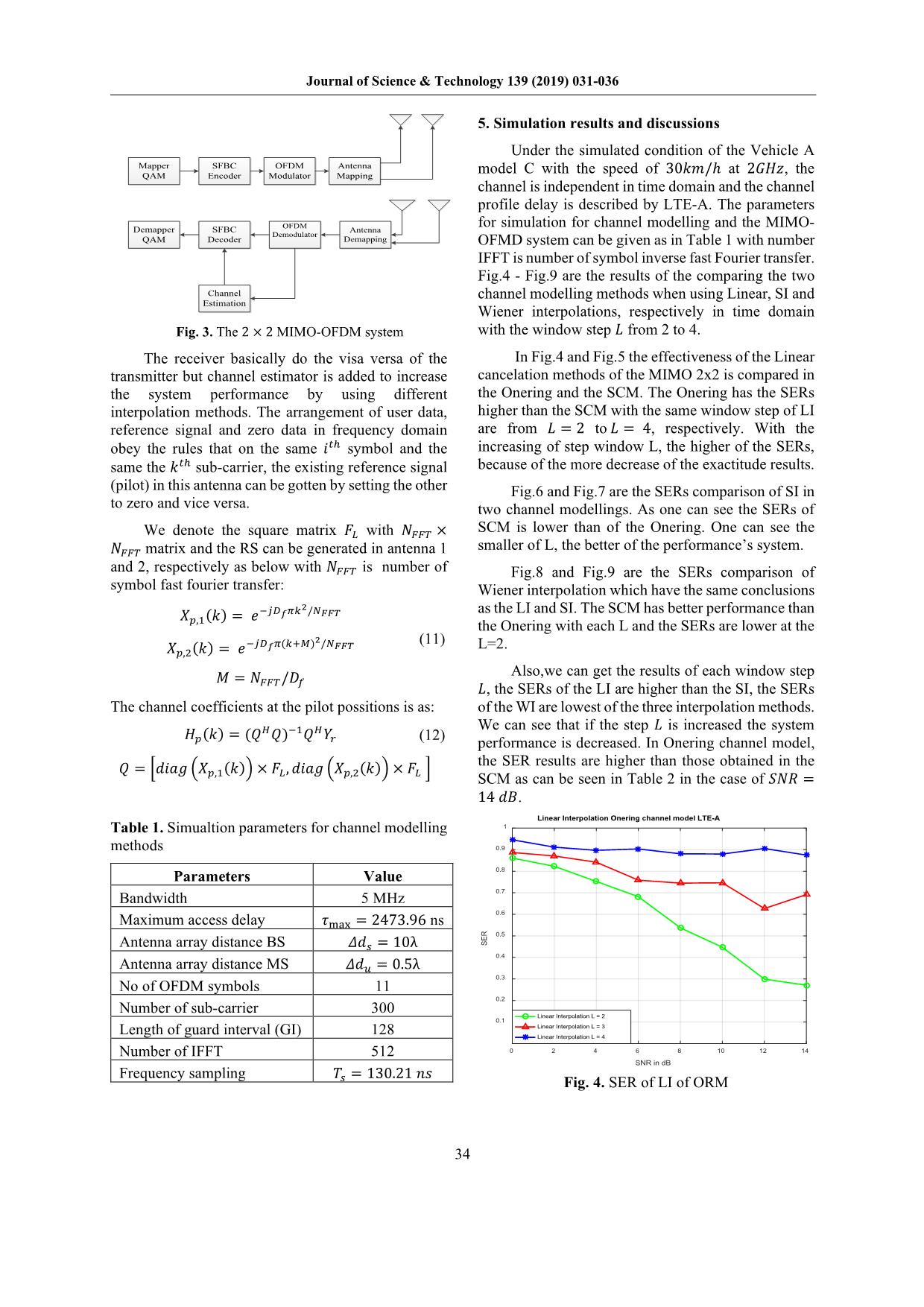
Trang 4
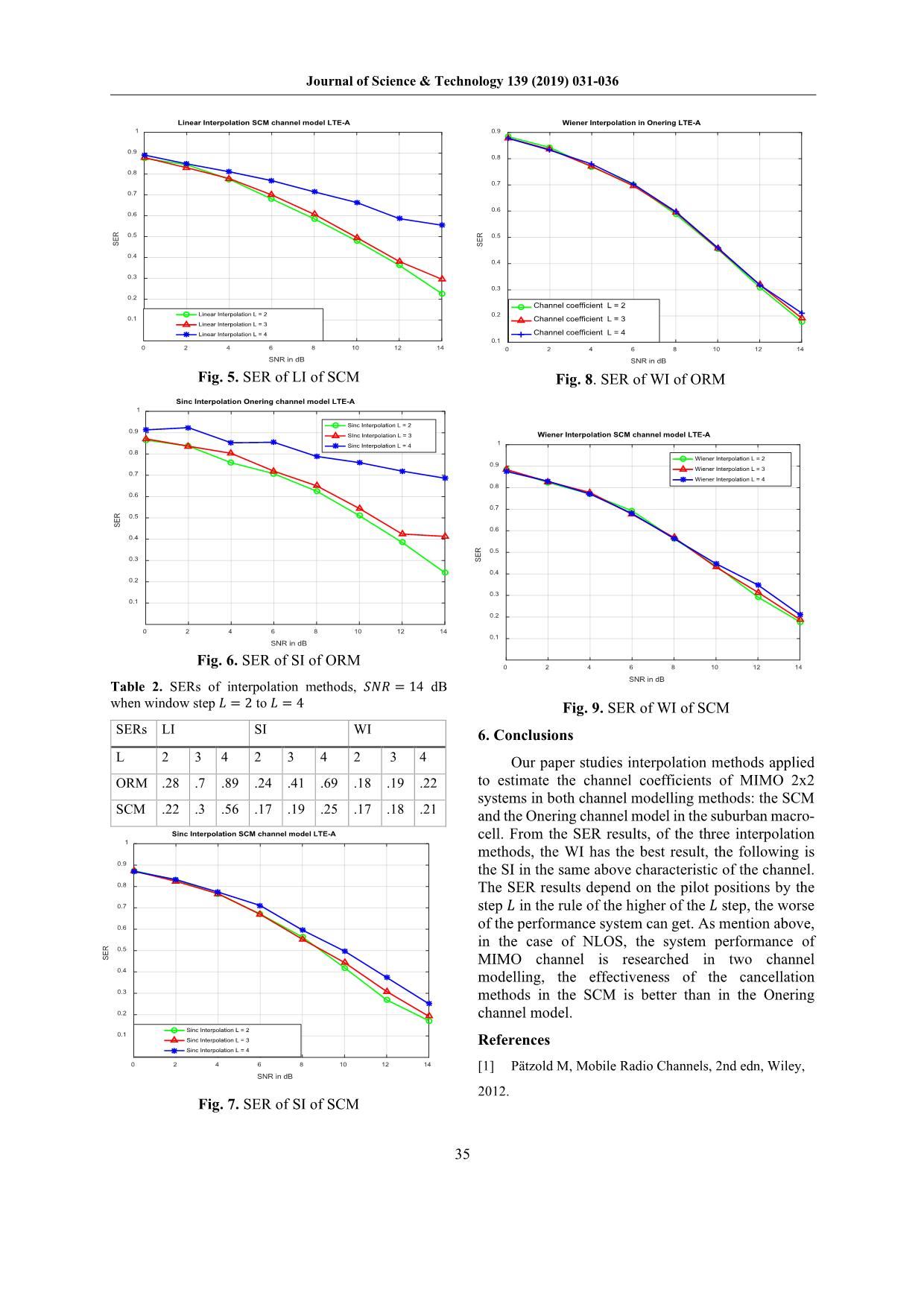
Trang 5
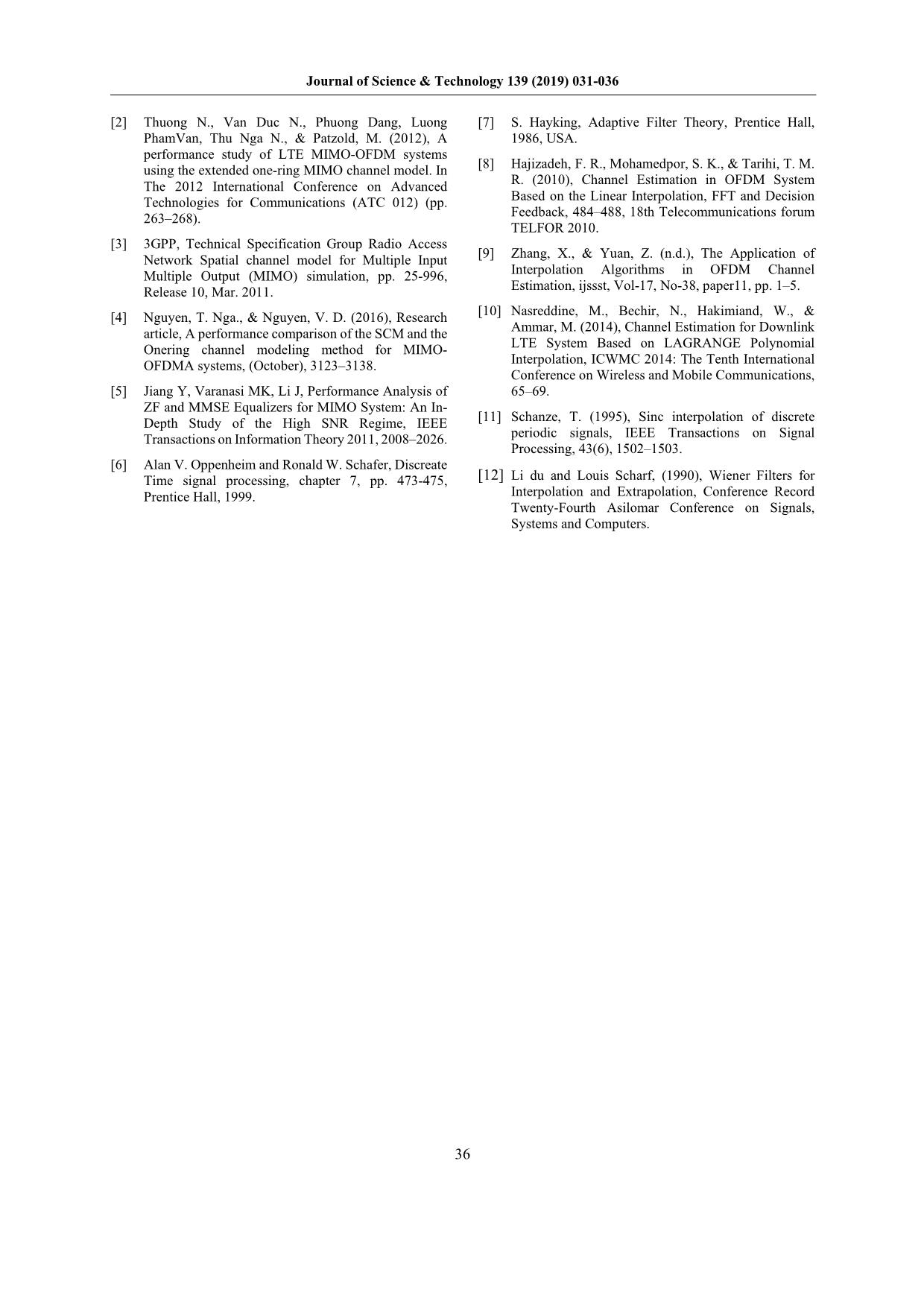
Trang 6
Tóm tắt nội dung tài liệu: A coded MIMO-OFDM system’s performance comparison of the spatial channel model and the onering channel model based on interpolation techniques
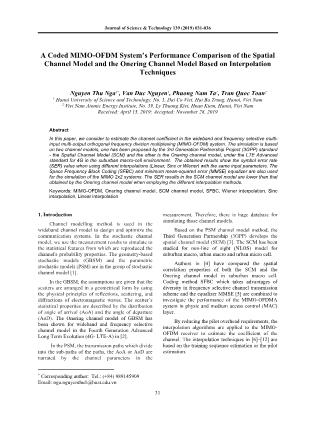
ows:𝑂𝑂𝑂𝑂 𝑙𝑙 , 𝑢𝑢 𝑠𝑠 form expression the channel impulse responses which 𝑂𝑂𝑂𝑂 𝐻𝐻 𝑓𝑓 𝑡𝑡 depend on the same condition: the delay power , ( , ) ℎ𝑢𝑢 𝑠𝑠 𝜏𝜏 𝑡𝑡 (2) function, the number of transmit and receive antennas. 𝑂𝑂𝑂𝑂 𝑢𝑢 𝑠𝑠 =𝐻𝐻 𝑓𝑓 𝑡𝑡 𝑁𝑁𝑙𝑙 × ( , ) , ) . 2.1. The Onering channel modelling approach ℒ , , , , 𝑙𝑙 𝑗𝑗�2𝜋𝜋 𝑓𝑓𝑛𝑛 𝑙𝑙𝑡𝑡−𝜏𝜏𝑙𝑙𝑓𝑓 +𝜃𝜃𝑛𝑛 𝑙𝑙 � 𝑐𝑐 𝑛𝑛 𝑠𝑠 𝑙𝑙 𝑛𝑛 𝑢𝑢 𝑙𝑙 In [1-2], authors describer the Onering channel � 𝑙𝑙 � 𝑎𝑎 𝑏𝑏 𝑒𝑒 models as the scatters are arranged around the mobile 𝑙𝑙 =and1 � 𝑁𝑁 𝑛𝑛= 1are the arrival and departure angles of the𝑀𝑀𝑀𝑀 reflection𝐵𝐵𝐵𝐵 path n, which come from the scatter station (MS), from which the scatters are assumed to 𝑛𝑛 𝑛𝑛 𝜙𝜙 𝜙𝜙 locate on a ring with the radius as in Fig.1. Sn. is the maximal departure angle of the transmitting𝐵𝐵𝐵𝐵 signal. αv is the angle from the horizontal 𝑚𝑚𝑚𝑚𝑚𝑚 𝑅𝑅 of the𝜙𝜙 velocity vector of MS. 2.2. The SCM channel modelling approach in NLOS v environment 𝑦𝑦 1 1 S n ℒ− 𝜑𝜑 𝐼𝐼ℒ− 1 1 MS α ∆d s α Φ MS BS BS Φ BS n ℒ Φ max α 𝜑𝜑 x n 𝐼𝐼 𝜑𝜑 v 𝐼𝐼ℒ 1 ∆du 1 𝐼𝐼ℒ 𝐼𝐼 −𝜑𝜑 ℒ 1− 𝜑𝜑 1 D ℒ−R −𝜑𝜑 𝐼𝐼ℒ− Fig. 1. The scatering Onering model [4] In the MIMO system with ( = 1,2, ) transmit antennas and ( = 1,2, ) receive Fig. 2. SCM with one cluster of scatters [3] 𝑆𝑆 𝑠𝑠 𝑆𝑆 antennas, and are the distance of base station The SCM is depicted in Fig.2, there are element 𝑈𝑈 𝑢𝑢 𝑈𝑈 (BS) and MS antenna element , respectively, the linear BS array and element linear MS array, the 𝑑𝑑𝑠𝑠 𝑑𝑑𝑢𝑢 channel impulse response (CIR) in time domain channel impulse respond function is given𝑆𝑆 for the 𝑠𝑠 modelled by the Onering channel method , ( , ) is wideband frequency 𝑈𝑈channel as, where τ is the time given as [1] with the angles αBS, αMS are the𝑂𝑂𝑂𝑂 angles of delay of the channel: ℎ𝑢𝑢 𝑠𝑠 𝜏𝜏 𝑡𝑡 32 Journal of Science & Technology 139 (2019) 031-036 ( , , ) , , + , ( ) = 𝐵𝐵𝐵𝐵 𝑛𝑛 𝑚𝑚 𝐴𝐴𝐴𝐴𝐴𝐴 𝑠𝑠 𝑛𝑛 𝑚𝑚 𝐴𝐴𝐴𝐴𝐴𝐴 𝑛𝑛 𝑚𝑚 . (3) , , 𝑀𝑀 ⎧�𝐺𝐺× 𝜃𝜃 , 𝑒𝑒𝑒𝑒𝑒𝑒, �𝑗𝑗�𝑘𝑘𝑑𝑑 𝑠𝑠𝑠𝑠𝑠𝑠�𝜃𝜃 ,� , 𝛷𝛷 ��⎫ 𝑆𝑆𝑆𝑆𝑆𝑆 𝑃𝑃𝑛𝑛𝜎𝜎𝑆𝑆𝑆𝑆 ⎪ ⎪ 𝑢𝑢 𝑠𝑠 𝑛𝑛 𝑀𝑀𝑀𝑀 𝑛𝑛 𝑚𝑚 𝐴𝐴𝐴𝐴𝐴𝐴 𝑢𝑢 𝑛𝑛 𝑚𝑚 𝐴𝐴𝐴𝐴𝐴𝐴 ℎ 𝑡𝑡 � � �×𝐺𝐺 �𝜃𝜃 � 𝑒𝑒𝑒𝑒𝑒𝑒�𝑗𝑗𝑗𝑗, 𝑑𝑑, 𝑠𝑠𝑠𝑠𝑠𝑠� 𝜃𝜃 �� 𝑀𝑀 𝑚𝑚=1 ⎨ ⎬ ⎪ 𝑛𝑛 𝑚𝑚 𝐴𝐴𝐴𝐴𝐴𝐴 𝑣𝑣 ⎪ ⎩ 𝑒𝑒𝑒𝑒𝑒𝑒�𝑗𝑗𝑗𝑗‖𝑣𝑣‖ 𝑐𝑐𝑐𝑐𝑐𝑐�𝜃𝜃 − 𝜃𝜃 � 𝑡𝑡� ⎭ , , ( , ) = , , ( ) ( ) 𝑆𝑆𝑆𝑆𝑆𝑆 𝑆𝑆𝑆𝑆𝑆𝑆 ℎ𝑢𝑢 𝑠𝑠 𝑛𝑛 𝜏𝜏 𝑡𝑡 ℎ𝑢𝑢 𝑠𝑠 𝑛𝑛 𝑡𝑡 𝛿𝛿 𝜏𝜏 − 𝜏𝜏𝑛𝑛 We assumed the lognormal shadow fading and channel coefficient in the all of OFDM symbols and antenna gain of both BS and MS are equal to one. The ( ); = 1, 2 is the channel coefficient in the transfer function is given as [4]: pilot symbols in the𝑝𝑝𝑝𝑝𝑝𝑝𝑝𝑝𝑝𝑝 time domain, the closed form 𝑁𝑁𝑁𝑁𝑁𝑁𝑁𝑁 ℎexpression𝑘𝑘 𝑘𝑘 data symbols𝑁𝑁 bases on pilot positions is as 𝑢𝑢𝑢𝑢𝑢𝑢 𝐻𝐻 following as in equation (7). The effectiveness of the ( , ) = 𝑁𝑁 ( ) × exp( j2 ), , , (4) channel estimation in interpolation methods depends 𝑁𝑁𝑁𝑁𝑁𝑁𝑁𝑁 𝐻𝐻𝑢𝑢𝑢𝑢𝑢𝑢 𝑓𝑓 𝑡𝑡 � ℎ𝑢𝑢 𝑠𝑠 𝑛𝑛 𝑡𝑡 − 𝜋𝜋𝜏𝜏𝑛𝑛𝑓𝑓 on the step value as the same as the LI. Therefore, we have:𝑛𝑛=1 ( ) 𝐿𝐿 ( , ) = sin ( ) ( ) = 𝑁𝑁𝑝𝑝𝑝𝑝𝑝𝑝𝑝𝑝𝑝𝑝 ( ) × . 𝑁𝑁 (7) 𝑁𝑁𝑁𝑁𝑁𝑁𝑁𝑁 [ , , + , ] × (𝜋𝜋 𝑛𝑛 − 𝑘𝑘)𝑘𝑘 𝐻𝐻𝑢𝑢𝑢𝑢𝑢𝑢 𝑓𝑓 𝑡𝑡 𝐿𝐿 exp sin × × ℎ 𝑛𝑛 �𝑛𝑛=1 � ℎ 𝑘𝑘 𝑠𝑠 𝑛𝑛 𝑚𝑚 𝐴𝐴𝐴𝐴𝐴𝐴, , 𝑛𝑛 𝑚𝑚 𝑘𝑘=1 𝜋𝜋 𝑛𝑛 − 𝑘𝑘𝑘𝑘 𝑃𝑃𝑛𝑛 𝑒𝑒𝑒𝑒𝑒𝑒�𝑗𝑗 𝑘𝑘𝑑𝑑 𝑠𝑠𝑠𝑠𝑠𝑠�𝜃𝜃 � 𝛷𝛷 � 3.3. The Wiener Interpolation (WI) 𝑁𝑁 𝑀𝑀 exp cos 𝐿𝐿 ∑𝑛𝑛=1 � 𝑀𝑀 ∑𝑚𝑚=1 � �𝑗𝑗𝑗𝑗𝑑𝑑𝑢𝑢 �𝜃𝜃,𝑛𝑛 𝑚𝑚, 𝐴𝐴𝐴𝐴𝐴𝐴�� � exp( j2 ). This method has been introduced in [12]. With 𝑛𝑛 𝑚𝑚 𝐴𝐴𝐴𝐴𝐴𝐴 𝑣𝑣 (5) �𝑗𝑗𝑗𝑗‖𝑣𝑣‖ �𝜃𝜃 − 𝜃𝜃 �𝜏𝜏� the assumption that , is the channel coefficient at whereby,− 𝜋𝜋 θ𝜏𝜏n𝑛𝑛,m𝑓𝑓,AoD and θn,m,AoA are the AoD and the AoA th th OFDM symbol and the sub-carrier, , is the for the m sub‐path of the n path; Φn,m is the phase of 𝐻𝐻�𝑖𝑖 𝑙𝑙 th th channel𝑡𝑡ℎ coefficient at the 𝑡𝑡ℎ sub-carrier and the the m sub‐path of the n path. The SCM method has 𝑖𝑖 𝑙𝑙 𝐻𝐻�𝑖𝑖′ 𝑝𝑝 N paths (N = 6), each path has M sub‐path (M = 20). OFDM symbol that contains𝑡𝑡 ℎthe pilot data, the input′ of𝑡𝑡ℎ Wiener filter is described as𝑝𝑝: 𝑖𝑖 3. Cancellation methods for 2×2 MIMO-OFDM system , = , , , , , , ′ ′ ′ In this section, the three popular interpolation 𝐻𝐻�𝑖𝑖 𝑙𝑙 ∑𝑖𝑖 𝑝𝑝 𝑤𝑤𝑖𝑖 𝑝𝑝 𝑖𝑖 𝑙𝑙 𝐻𝐻�𝑖𝑖 𝑝𝑝 (8) methods: Linear, Sinc and Wiener interpolation are Set the matrix coefficient of the filter as: applied to study the performance of MIMO-OFDM system. , (9) 𝑇𝑇 = ( , , , , , , , , , , ( ) , , , ) 3.1. The Linear Interpolation (LI) 𝑊𝑊𝑖𝑖 𝑙𝑙 , ′ 1 1 𝑖𝑖 𝑙𝑙 𝑖𝑖 𝑝𝑝 𝑖𝑖 𝑙𝑙 ℓ𝑡𝑡−1 𝐷𝐷𝑡𝑡+1 �ℓ𝑓𝑓−1�𝐷𝐷𝑓𝑓+1 𝑖𝑖 𝑙𝑙 With the assumption of that the interpolation Therefore,𝑤𝑤 we have𝑤𝑤 : 𝑤𝑤 approach is in shift invariant, LI [6]-[9] relies on two , = , , . (10) consecutive pilot positions in both time and frequency 𝑇𝑇 domains. where𝐻𝐻� 𝑖𝑖 𝑙𝑙 , 𝑊𝑊 are𝑖𝑖 𝑙𝑙 𝐻𝐻 �the𝑖𝑖′ 𝑝𝑝 number of OFDM symbols that contain pilots in the time and frequency axis, If the frequency interval of the neighboring pilot 𝑡𝑡 𝑓𝑓 ℓ ℓ subcarrier is , the index of the non-pilot subcarrier respectively, , , , is the filter coefficients. and are distance of ′pilots in frequency and time domain, between two adjacent pilots is , the index of pilot 𝑤𝑤𝑖𝑖 𝑝𝑝 𝑖𝑖 𝑙𝑙 𝐷𝐷𝑓𝑓 𝐷𝐷𝑡𝑡 subcarriers is𝐿𝐿 . The transfer function for non-pilot respectively. subcarriers between and 𝑙𝑙( + 1) pilots is 4. Description the × MIMO-OFDM system described as: 𝑝𝑝 𝑡𝑡ℎ 𝑡𝑡ℎ 𝑘𝑘 𝑘𝑘 We consider a 𝟐𝟐2×2 𝟐𝟐MIMO system as in Fig.3 with (6) ( + ) = 1 ( ) + ( + 1). the transmitter and receiver. In the transmitter, signal 𝑙𝑙 𝑙𝑙 is modulated by QAM-64, then using SFBC to 𝐻𝐻� 𝑘𝑘𝑘𝑘 𝑙𝑙 � − � 𝐻𝐻�𝑝𝑝 𝑘𝑘 � � 𝐻𝐻�𝑝𝑝 𝑘𝑘 advantage diversity in space and frequency domain. where ( ) is the transfer𝐿𝐿 function𝐿𝐿 of the pilot. 3.2. The𝐻𝐻𝑝𝑝 Sinc𝑘𝑘 Interpolation (SI) This method has been introduced in [10]-[11]. With the assumption that ( ); = 1, 2 is the ℎ 𝑛𝑛 𝑛𝑛 𝑁𝑁 33 Journal of Science & Technology 139 (2019) 031-036 5. Simulation results and discussions Under the simulated condition of the Vehicle A Mapper SFBC OFDM Antenna 30 / 2 QAM Encoder Modulator Mapping model C with the speed of at , the channel is independent in time domain and the channel profile delay is described by LTE𝑘𝑘𝑘𝑘-A. ℎThe parameters𝐺𝐺𝐺𝐺𝐺𝐺 OFDM Demapper SFBC Antenna for simulation for channel modelling and the MIMO- Demodulator QAM Decoder Demapping OFMD system can be given as in Table 1 with number IFFT is number of symbol inverse fast Fourier transfer. Fig.4 - Fig.9 are the results of the comparing the two Channel channel modelling methods when using Linear, SI and Estimation Wiener interpolations, respectively in time domain Fig. 3. The 2 × 2 MIMO-OFDM system with the window step from 2 to 4. The receiver basically do the visa versa of the In Fig.4 and Fig.5𝐿𝐿 the effectiveness of the Linear transmitter but channel estimator is added to increase cancelation methods of the MIMO 2x2 is compared in the system performance by using different the Onering and the SCM. The Onering has the SERs interpolation methods. The arrangement of user data, higher than the SCM with the same window step of LI reference signal and zero data in frequency domain are from = 2 to = 4, respectively. With the obey the rules that on the same symbol and the increasing of step window L, the higher of the SERs, same the sub-carrier, the existing𝑡𝑡ℎ reference signal because of 𝐿𝐿the more decrease𝐿𝐿 of the exactitude results. 𝑖𝑖 (pilot) in this𝑡𝑡ℎ antenna can be gotten by setting the other Fig.6 and Fig.7 are the SERs comparison of SI in 𝑘𝑘 to zero and vice versa. two channel modellings. As one can see the SERs of We denote the square matrix with × SCM is lower than of the Onering. One can see the matrix and the RS can be generated in antenna 1 smaller of L, the better of the performance’s system. 𝐹𝐹𝐿𝐿 𝑁𝑁𝐹𝐹𝐹𝐹𝐹𝐹 and 2, respectively as below with is number of Fig.8 and Fig.9 are the SERs comparison of 𝑁𝑁𝐹𝐹𝐹𝐹𝐹𝐹 symbol fast fourier transfer: Wiener interpolation which have the same conclusions 𝑁𝑁𝐹𝐹𝐹𝐹𝐹𝐹 / as the LI and SI. The SCM has better performance than , ( ) = 2 the Onering with each L and the SERs are lower at the −𝑗𝑗𝐷𝐷𝑓𝑓𝜋𝜋𝑘𝑘 𝑁𝑁𝐹𝐹𝐹𝐹𝐹𝐹 𝑝𝑝 1 ( ) / (11) L=2. 𝑋𝑋, ( )𝑘𝑘= 𝑒𝑒 2 −𝑗𝑗𝐷𝐷𝑓𝑓𝜋𝜋 𝑘𝑘+𝑀𝑀 𝑁𝑁𝐹𝐹𝐹𝐹𝐹𝐹 𝑝𝑝 2 = / Also,we can get the results of each window step 𝑋𝑋 𝑘𝑘 𝑒𝑒 , the SERs of the LI are higher than the SI, the SERs The channel coefficients𝑀𝑀 𝑁𝑁𝐹𝐹𝐹𝐹𝐹𝐹 at the𝐷𝐷𝑓𝑓 pilot possitions is as: of the WI are lowest of the three interpolation methods. 𝐿𝐿We can see that if the step is increased the system ( ) = ( ) (12) performance is decreased. In Onering channel model, 𝐻𝐻 −1 𝐻𝐻 𝐿𝐿 = 𝐻𝐻𝑝𝑝 𝑘𝑘 ( ) 𝑄𝑄× 𝑄𝑄 , 𝑄𝑄 𝑌𝑌𝑟𝑟 ( ) × the SER results are higher than those obtained in the , , SCM as can be seen in Table 2 in the case of = 𝑄𝑄 �𝑑𝑑𝑑𝑑𝑑𝑑𝑑𝑑 �𝑋𝑋𝑝𝑝 1 𝑘𝑘 � 𝐹𝐹𝐿𝐿 𝑑𝑑𝑑𝑑𝑑𝑑𝑑𝑑 �𝑋𝑋𝑝𝑝 2 𝑘𝑘 � 𝐹𝐹𝐿𝐿 � 14 . Linear Interpolation Onering channel model LTE-A 𝑆𝑆𝑆𝑆𝑆𝑆 Table 1. Simualtion parameters for channel modelling 𝑑𝑑𝑑𝑑1 methods 0.9 0.8 Parameters Value 0.7 Bandwidth 5 MHz 0.6 Maximum access delay = 2473.96 ns 0.5 Antenna array distance BS max = 10 SER 𝜏𝜏 0.4 Antenna array distance MS 𝑠𝑠 = 0.5 𝛥𝛥𝛥𝛥 λ 0.3 No of OFDM symbols 𝑢𝑢 11 𝛥𝛥𝛥𝛥 λ 0.2 Number of sub-carrier 300 Linear Interpolation L = 2 0.1 Linear Interpolation L = 3 Length of guard interval (GI) 128 Linear Interpolation L = 4 Number of IFFT 512 0 2 4 6 8 10 12 14 SNR in dB Frequency sampling = 130.21 Fig. 4. SER of LI of ORM 𝑠𝑠 𝑇𝑇 𝑛𝑛𝑛𝑛 34 Journal of Science & Technology 139 (2019) 031-036 Linear Interpolation SCM channel model LTE-A Wiener Interpolation in Onering LTE-A 1 0.9 0.9 0.8 0.8 0.7 0.7 0.6 0.6 0.5 0.5 SER SER 0.4 0.4 0.3 0.3 0.2 Channel coefficient L = 2 Linear Interpolation L = 2 0.2 0.1 Channel coefficient L = 3 Linear Interpolation L = 3 Linear Interpolation L = 4 Channel coefficient L = 4 0.1 0 2 4 6 8 10 12 14 0 2 4 6 8 10 12 14 SNR in dB SNR in dB Fig. 5. SER of LI of SCM Fig. 8. SER of WI of ORM Sinc Interpolation Onering channel model LTE-A 1 Sinc Interpolation L = 2 0.9 SInc Interpolation L = 3 Wiener Interpolation SCM channel model LTE-A Sinc Interpolation L = 4 1 0.8 Wiener Interpolation L = 2 0.9 Wiener Interpolation L = 3 0.7 Wiener Interpolation L = 4 0.8 0.6 0.7 0.5 SER 0.6 0.4 0.5 0.3 SER 0.4 0.2 0.3 0.1 0.2 0 2 4 6 8 10 12 14 0.1 SNR in dB Fig. 6. SER of SI of ORM 0 2 4 6 8 10 12 14 SNR in dB Table 2. SERs of interpolation methods, = 14 dB when window step = 2 to = 4 Fig. 9. SER of WI of SCM 𝑆𝑆𝑆𝑆𝑆𝑆 SERs LI 𝐿𝐿 SI 𝐿𝐿 WI 6. Conclusions L 2 3 4 2 3 4 2 3 4 Our paper studies interpolation methods applied ORM .28 .7 .89 .24 .41 .69 .18 .19 .22 to estimate the channel coefficients of MIMO 2x2 systems in both channel modelling methods: the SCM SCM .22 .3 .56 .17 .19 .25 .17 .18 .21 and the Onering channel model in the suburban macro- Sinc Interpolation SCM channel model LTE-A 1 cell. From the SER results, of the three interpolation methods, the WI has the best result, the following is 0.9 the SI in the same above characteristic of the channel. 0.8 The SER results depend on the pilot positions by the 0.7 step in the rule of the higher of the step, the worse 0.6 of the performance system can get. As mention above, 𝐿𝐿 𝐿𝐿 0.5 in the case of NLOS, the system performance of SER MIMO channel is researched in two channel 0.4 modelling, the effectiveness of the cancellation 0.3 methods in the SCM is better than in the Onering 0.2 channel model. Sinc Interpolation L = 2 0.1 Sinc Interpolation L = 3 References Sinc Interpolation L = 4 0 2 4 6 8 10 12 14 [1] Pätzold M, Mobile Radio Channels, 2nd edn, Wiley, SNR in dB 2012. Fig. 7. SER of SI of SCM 35 Journal of Science & Technology 139 (2019) 031-036 [2] Thuong N., Van Duc N., Phuong Dang, Luong [7] S. Hayking, Adaptive Filter Theory, Prentice Hall, PhamVan, Thu Nga N., & Patzold, M. (2012), A 1986, USA. performance study of LTE MIMO-OFDM systems using the extended one-ring MIMO channel model. In [8] Hajizadeh, F. R., Mohamedpor, S. K., & Tarihi, T. M. The 2012 International Conference on Advanced R. (2010), Channel Estimation in OFDM System Technologies for Communications (ATC 012) (pp. Based on the Linear Interpolation, FFT and Decision 263–268). Feedback, 484–488, 18th Telecommunications forum TELFOR 2010. [3] 3GPP, Technical Specification Group Radio Access Network Spatial channel model for Multiple Input [9] Zhang, X., & Yuan, Z. (n.d.), The Application of Multiple Output (MIMO) simulation, pp. 25-996, Interpolation Algorithms in OFDM Channel Release 10, Mar. 2011. Estimation, ijssst, Vol-17, No-38, paper11, pp. 1–5. [4] Nguyen, T. Nga., & Nguyen, V. D. (2016), Research [10] Nasreddine, M., Bechir, N., Hakimiand, W., & article, A performance comparison of the SCM and the Ammar, M. (2014), Channel Estimation for Downlink Onering channel modeling method for MIMO- LTE System Based on LAGRANGE Polynomial OFDMA systems, (October), 3123–3138. Interpolation, ICWMC 2014: The Tenth International Conference on Wireless and Mobile Communications, [5] Jiang Y, Varanasi MK, Li J, Performance Analysis of 65–69. ZF and MMSE Equalizers for MIMO System: An In- Depth Study of the High SNR Regime, IEEE [11] Schanze, T. (1995), Sinc interpolation of discrete Transactions on Information Theory 2011, 2008–2026. periodic signals, IEEE Transactions on Signal Processing, 43(6), 1502–1503. [6] Alan V. Oppenheim and Ronald W. Schafer, Discreate Time signal processing, chapter 7, pp. 473-475, [12] Li du and Louis Scharf, (1990), Wiener Filters for Prentice Hall, 1999. Interpolation and Extrapolation, Conference Record Twenty-Fourth Asilomar Conference on Signals, Systems and Computers. 36
File đính kèm:
 a_coded_mimo_ofdm_systems_performance_comparison_of_the_spat.pdf
a_coded_mimo_ofdm_systems_performance_comparison_of_the_spat.pdf

